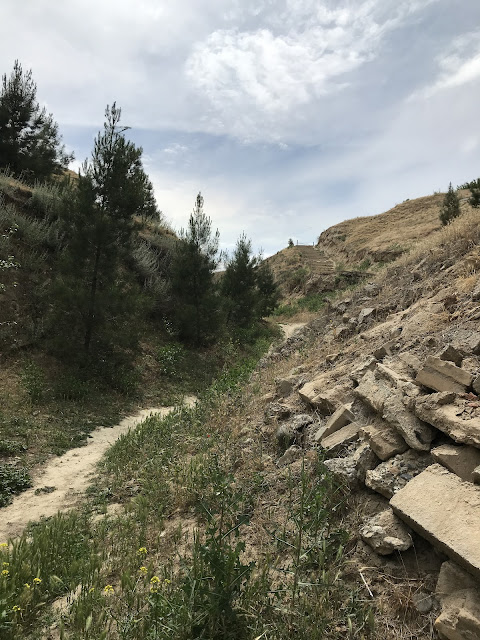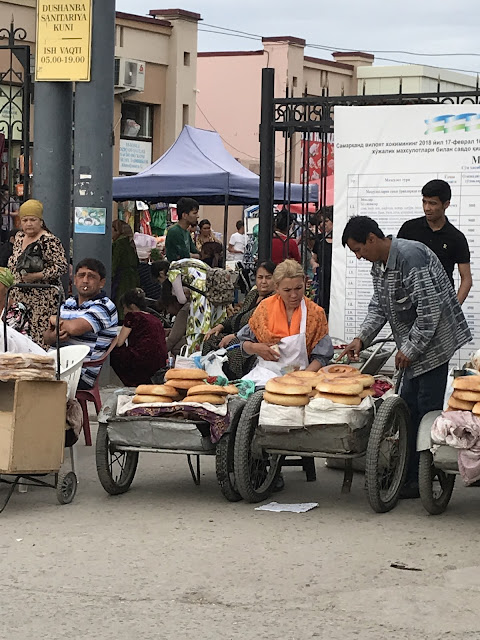Life in this ancient place, ancient Samarkand, ended seven centuries ago but has attracted many teams of archaeologists intent on
exploring the 11 different cultural layers of its occupation over time. By whatever name, Afrosiab, Samarkand or Marakanda to the Greeks (Alexander the Great visited
here), this was the centre of trade along many international trade routes, a centre of
influence and wealth. Emissaries and diplomats from many countries including
the Vatican visited here. We saw large fragments of wall murals depicting such visits.
 |
| This is part of the ancient Tell |
 |
| looking up to Daniel's mausoleum |
 |
| Daniels' sarcophagus |
Amir Timur brought the remains of, and built a mausoleum
for, the Old Testament prophet Daniel out of deep respect for the man. And we
came here to see that. Daniel’s mausoleum is on the edge of the old Afrosiab. It is considered a very sacred place; we had to wash before entering. Inside it engendered a strong feeling of reverence. Legend has it that a pistachio tree, over 600 year old which grows outside the mausoleum, started to bear fruit when Daniel’s remains were brought here. It was an intriguing place. In the face of one of the old excavated walls we saw a doorway into we knew not what. Would have been marvellous to go and see!
 |
| The 600 year old pistachio tree |
Everywhere we went people were so friendly and really keen to have photos taken with us. We felt rather like curios.
We were on the edge of the archeological excavations of the Tell of Asfrosiab and a narrow pathway led to other parts of the site. Lindsay walked up the hill but our guide was reluctant to go there because there were supposed to be snakes, foxes and other ‘scary’ things. So we didn't go further. Sadly I missed out on seeing what remains of the early C15 observatory built by Ulugh Beg.
 |
| We missed out on whatever archaeological wonders awaited us over that rise! |
But we did visit the museum attached to the excavations and it was truly worth the visit. We came out brimming with snippets of history, enough to keep us happily mulling over for hours.
 |
| Images of the excavation site |
 |
| Fragments of murals depicting gifts presented by emissaries from other countries. |
We finished our day with a visit to the central markets which were full of enticing smells and colours; we bought a sample of ‘fudge’ and some sesame confection. A vast sea of vibrant colours and shapes - many things unidentifiable, others familiar. The smells and colours were wonderful!
 |
| A wonky panoramic shot of the market! |
 |
| Bread vendors |
Near one of the entrances to the markets there was a large gathering the bread vendors. Fascinating to watch - the bread is oiler to a golden sheen. The smell was intoxicating! And after a day of walking about 10km we were ready for a rest and food.
After a few days of visiting mosques, we felt rather mosqued-out, but like the old churches and cathedrals of Christendom, it is from these structures that the history of a people can often be gleaned. It is all part of that big jigsaw picture puzzle, this mosaic history that we want to learn more about by travelling this ancient international trading route.
Tomorrow we head west for Bukhara and the desert .......












No comments:
Post a Comment